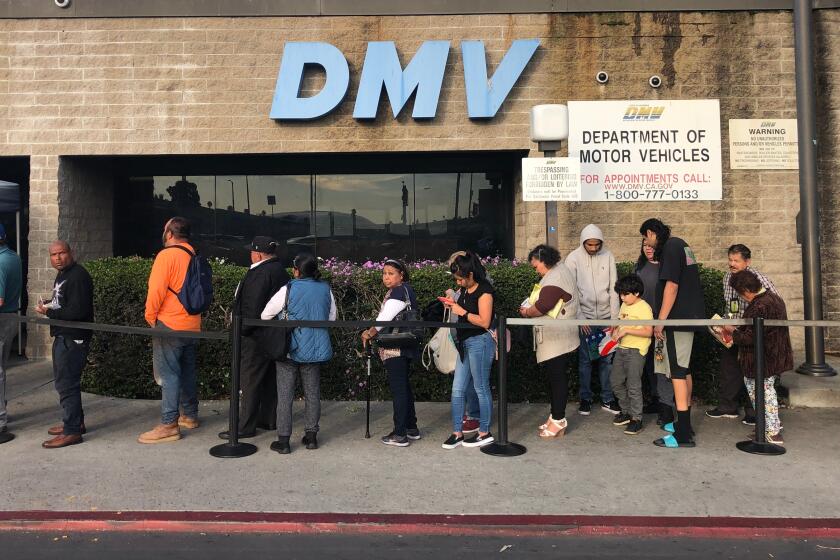Anti-Drug Crusaders Court Success : Education: Drug Use Is Life Abuse is at odds with some local judges, but no one disputes the program’s winning record.
- Share via
SANTA ANA — Each time a judge in Orange County advocates legalizing drugs, Julie Holt cringes.
As director of the county’s Drug Use Is Life Abuse program, she believes that the debate on decriminalizing drug use undermines the efforts of her organization.
“Every time I hear someone come out in favor of legalization, I feel frustrated and sad,” Holt said. “It takes up a lot of our resources to respond to them.”
Though she criticizes calls for legalization, proponents of such plans praise her program, which has established itself as a national model for educating youth on the evils of drugs. It is one of the few programs that both sides agree is winning ground in the war on drugs.
“I totally support their efforts,” said U.S. Magistrate Ronald W. Rose, one of three local judges who say the drug war, with its emphasis on crime and punishment, is not succeeding and who support decriminalizing drug use.
Drug Use Is Life Abuse officials recently jumped into the debate with results of a poll it commissioned on drug attitudes, showing that 80% of county residents oppose the idea of decriminalizing drugs. The poll was characterized by Orange County Sheriff Brad Gates as a “rejection” of the views of the three local jurists.
Holt said legalizing adult drug use, as proposed by Rose and Superior Court Judges James P. Gray and James L. Smith, would be detrimental to the nation’s youth.
“It’s a message that, at the minimum, drugs are not too bad, or worse, that they’re fine and go ahead and use them,” Holt said.
What started as little more than an ambitious idea and a bumper sticker in 1987 has evolved into substantial community and business effort to eliminate drug use.
In the beginning, the annual budget for Drug Use Is Life Abuse was just a few thousand dollars; now it’s more than $800,000. Scattered projects of the early days have been organized into strategic marketing plans. And the logo seems to be everywhere, from stickers on storefronts and cars to patches on the uniforms of the National Guard. The Los Angeles Rams even wore the patches for a year, before the National Football League ordered them removed.
The organization’s educational programs for youth have given it a strong presence in county schools, and organizers say their next big effort will be a drive to introduce drug-free policies for the workplace.
“We want parents getting the same information that their kids are,” Holt said. “Education and prevention--that’s what we are all about.”
Drug Use Is Life Abuse was the brainchild of Gates and local businessman Michael K. Hayde.
Gates said he realized in the mid-1980s that law enforcement could do only so much to fight the drug dealers and users. “We needed to get involved in changing the attitude (and tell people) that drugs were not OK,” Gates said. “We needed to work on education and prevention.”
Hayde, who lost a close relative to a cocaine overdose, backed the program with thousands of dollars of his own money for the first couple of years and worked hard to attract the support of the business community.
“He really put his heart and soul into it,” Gates said.
One of the first things the nonprofit organization did was aggressively market its logo, putting it “on everything we could,” Holt said. “It was part of creating an atmosphere that we don’t support drugs and the whole county is behind us.”
The organization’s bumper sticker is much of the reason that Drug Use is Life Abuse enjoys high recognition in the county. According to the group’s recent poll, 73% of county residents have heard of the program.
The program is run by 35 board members, two full-time employees and one part-time employee. The three staffers work in a small Santa Ana office, sharing space with the Sheriff’s Department’s Drug Education Unit.
The Sheriff’s Department is closely linked to the organization. Its deputies teach educational programs in the schools, and Gates attends many of its functions and events.
In fact, if there’s any criticism about the program, it comes from opponents of Gates who feel that he uses it as a platform to gain political mileage.
“But that’s not really correct,” Holt said. “He has been very, very supportive. I don’t care what people say about him. He is very committed to this issue and is very sincere.”
At a time when the nation’s war on drugs is being called a failure by some, Holt and others say Drug Use Is Life Abuse is making significant progress.
Although there are no statistics directly linking a decline in drug use to the program’s efforts, Holt points to local data showing a decrease in the number of drug-related deaths among high school students in the past five years.
In 1987, 20 high school students in the county died from drug-related causes, compared to four in 1991. So far this year, two students have died from overdoses.
“It’s programs like ours and the efforts of law enforcement, parent groups and others that are making an impact through education and awareness,” Holt said.
Yet, for all the education efforts statewide in recent years, statistics indicate that there is no clear trend in student drug use. A 1991-92 study of seventh-, ninth- and 11th-graders in California showed a decrease in most illicit drug use from 1985 to 1986. But alcohol consumption, which had been going down, took a turn up, despite an increase in students who believe that regular use is harmful. LSD and tobacco use also has increased.
Holt said plans are underway to track students who participate in Drug Use Is Life Abuse programs to see how effective the lessons are.
Meanwhile, success is measured in other ways: the 100,000 students the organization has reached through its classes, the national acclaim and honors from President Bush, and the considerable support it gets from the business community.
Gates attributes much of the program’s success to the involvement of high school students who formed Students Against Drug Abuse and “came up with 90% of the items that we used.” A student even designed the group’s logo.
Also critical to the growth of the organization was participation by the business community. At first, businesses were asked to support the program only by displaying the logo. Financial donations were not solicited, Gates said.
Soon businesses were asking to join the effort because a competitor was involved, Gates said. Financial and in-kind donations followed.
While many nonprofit organizations face financially lean times, Drug Use Is Life Abuse still receives healthy donations from the business community.
Most of the money goes toward educational materials for local elementary schools, including colorful comic book-like pamphlets and stickers in English and Spanish. Teachers and law enforcement teamed up to develop the lesson plans.
One pamphlet, “Positively kNOw Drugs,” which is given to fifth-graders, discusses topics such as “What Is a Drug,” “Gateway Drugs,” “Who Is a Drug Abuser” and “Families and Addictions.”
The educational programs are similar to others in the county, including the national Drug Abuse Resistance Education (DARE) program, which was started by the Los Angeles Police Department and is taught at many county schools by police agencies.
“It’s an excellent education program,” Holt said of DARE. “We share our materials with them occasionally.”
Whereas DARE concentrates on education in the schools and has a more comprehensive curriculum, Drug Use Is Life Abuse has a larger, communitywide focus.
Holt said the Drug Use Is Life Abuse program is recognized as one of the top three in the nation by the President’s Drug Advisory Council. People from throughout the nation have tried to imitate the organization, she said.
“We’re always getting calls from people wanting information on how to start a program,” Holt said. “This is what we need, more community involvement.”










